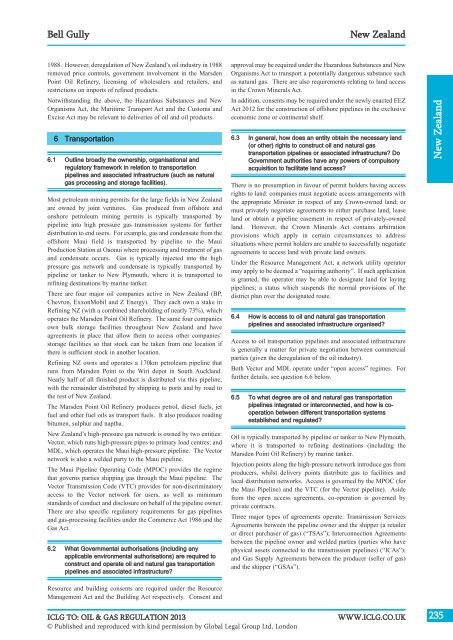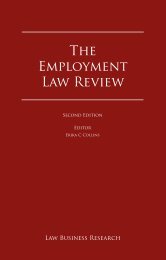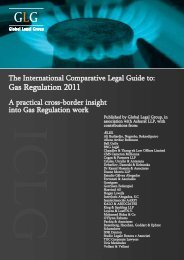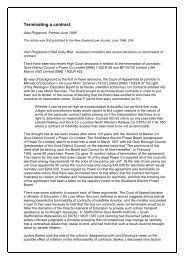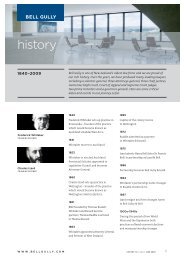Oil & Gas Regulation 2013
NZ Oil & Gas Chapter - The International Comparative ... - Bell Gully
NZ Oil & Gas Chapter - The International Comparative ... - Bell Gully
You also want an ePaper? Increase the reach of your titles
YUMPU automatically turns print PDFs into web optimized ePapers that Google loves.
Bell Gully<br />
New Zealand<br />
1988. However, deregulation of New Zealand’s oil industry in 1988<br />
removed price controls, government involvement in the Marsden<br />
Point <strong>Oil</strong> Refinery, licensing of wholesalers and retailers, and<br />
restrictions on imports of refined products.<br />
Notwithstanding the above, the Hazardous Substances and New<br />
Organisms Act, the Maritime Transport Act and the Customs and<br />
Excise Act may be relevant to deliveries of oil and oil products.<br />
6 Transportation<br />
6.1 Outline broadly the ownership, organisational and<br />
regulatory framework in relation to transportation<br />
pipelines and associated infrastructure (such as natural<br />
gas processing and storage facilities).<br />
Most petroleum mining permits for the large fields in New Zealand<br />
are owned by joint ventures. <strong>Gas</strong> produced from offshore and<br />
onshore petroleum mining permits is typically transported by<br />
pipeline into high pressure gas transmission systems for further<br />
distribution to end users. For example, gas and condensate from the<br />
offshore Maui field is transported by pipeline to the Maui<br />
Production Station at Oaonui where processing and treatment of gas<br />
and condensate occurs. <strong>Gas</strong> is typically injected into the high<br />
pressure gas network and condensate is typically transported by<br />
pipeline or tanker to New Plymouth, where it is transported to<br />
refining destinations by marine tanker.<br />
There are four major oil companies active in New Zealand (BP,<br />
Chevron, ExxonMobil and Z Energy). They each own a stake in<br />
Refining NZ (with a combined shareholding of nearly 73%), which<br />
operates the Marsden Point <strong>Oil</strong> Refinery. The same four companies<br />
own bulk storage facilities throughout New Zealand and have<br />
agreements in place that allow them to access other companies’<br />
storage facilities so that stock can be taken from one location if<br />
there is sufficient stock in another location.<br />
Refining NZ owns and operates a 170km petroleum pipeline that<br />
runs from Marsden Point to the Wiri depot in South Auckland.<br />
Nearly half of all finished product is distributed via this pipeline,<br />
with the remainder distributed by shipping to ports and by road to<br />
the rest of New Zealand.<br />
The Marsden Point <strong>Oil</strong> Refinery produces petrol, diesel fuels, jet<br />
fuel and other fuel oils as transport fuels. It also produces roading<br />
bitumen, sulphur and naptha.<br />
New Zealand’s high-pressure gas network is owned by two entities:<br />
Vector, which runs high-pressure pipes to primary load centres; and<br />
MDL, which operates the Maui high-pressure pipeline. The Vector<br />
network is also a welded party to the Maui pipeline.<br />
The Maui Pipeline Operating Code (MPOC) provides the regime<br />
that governs parties shipping gas through the Maui pipeline. The<br />
Vector Transmission Code (VTC) provides for non-discriminatory<br />
access to the Vector network for users, as well as minimum<br />
standards of conduct and disclosure on behalf of the pipeline owner.<br />
There are also specific regulatory requirements for gas pipelines<br />
and gas-processing facilities under the Commerce Act 1986 and the<br />
<strong>Gas</strong> Act.<br />
6.2 What Governmental authorisations (including any<br />
applicable environmental authorisations) are required to<br />
construct and operate oil and natural gas transportation<br />
pipelines and associated infrastructure?<br />
approval may be required under the Hazardous Substances and New<br />
Organisms Act to transport a potentially dangerous substance such<br />
as natural gas. There are also requirements relating to land access<br />
in the Crown Minerals Act.<br />
In addition, consents may be required under the newly enacted EEZ<br />
Act 2012 for the construction of offshore pipelines in the exclusive<br />
economic zone or continental shelf.<br />
6.3 In general, how does an entity obtain the necessary land<br />
(or other) rights to construct oil and natural gas<br />
transportation pipelines or associated infrastructure? Do<br />
Government authorities have any powers of compulsory<br />
acquisition to facilitate land access?<br />
There is no presumption in favour of permit holders having access<br />
rights to land: companies must negotiate access arrangements with<br />
the appropriate Minister in respect of any Crown-owned land; or<br />
must privately negotiate agreements to either purchase land, lease<br />
land or obtain a pipeline easement in respect of privately-owned<br />
land. However, the Crown Minerals Act contains arbitration<br />
provisions which apply in certain circumstances to address<br />
situations where permit holders are unable to successfully negotiate<br />
agreements to access land with private land owners.<br />
Under the Resource Management Act, a network utility operator<br />
may apply to be deemed a “requiring authority”. If such application<br />
is granted, the operator may be able to designate land for laying<br />
pipelines; a status which suspends the normal provisions of the<br />
district plan over the designated route.<br />
6.4 How is access to oil and natural gas transportation<br />
pipelines and associated infrastructure organised?<br />
Access to oil transportation pipelines and associated infrastructure<br />
is generally a matter for private negotiation between commercial<br />
parties (given the deregulation of the oil industry).<br />
Both Vector and MDL operate under “open access” regimes. For<br />
further details, see question 6.6 below.<br />
6.5 To what degree are oil and natural gas transportation<br />
pipelines integrated or interconnected, and how is cooperation<br />
between different transportation systems<br />
established and regulated?<br />
<strong>Oil</strong> is typically transported by pipeline or tanker to New Plymouth,<br />
where it is transported to refining destinations (including the<br />
Marsden Point <strong>Oil</strong> Refinery) by marine tanker.<br />
Injection points along the high-pressure network introduce gas from<br />
producers, whilst delivery points distribute gas to facilities and<br />
local distribution networks. Access is governed by the MPOC (for<br />
the Maui Pipeline) and the VTC (for the Vector pipeline). Aside<br />
from the open access agreements, co-operation is governed by<br />
private contracts.<br />
Three major types of agreements operate: Transmission Services<br />
Agreements between the pipeline owner and the shipper (a retailer<br />
or direct purchaser of gas) (“TSAs”); Interconnection Agreements<br />
between the pipeline owner and welded parties (parties who have<br />
physical assets connected to the transmission pipelines) (“ICAs”);<br />
and <strong>Gas</strong> Supply Agreements between the producer (seller of gas)<br />
and the shipper (“GSAs”).<br />
New Zealand<br />
Resource and building consents are required under the Resource<br />
Management Act and the Building Act respectively. Consent and<br />
ICLG TO: OIL & GAS REGULATION <strong>2013</strong> WWW.ICLG.CO.UK 235<br />
© Published and reproduced with kind permission by Global Legal Group Ltd, London


